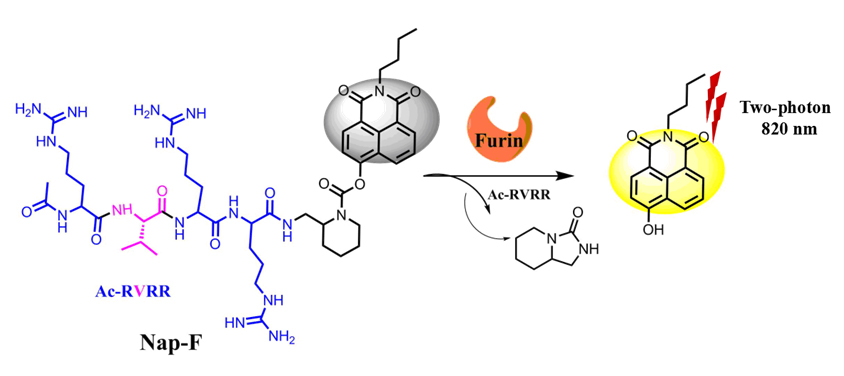[1] Steiner, D. F. Curr. Opin. Chem. Biol. 1998, 2, 31.
[2] Seidah, N. G.; Mayer, G.; Zaid, A.; Rousselet, E.; Nassoury, N.; Poirier, S.; Essalmani, R.; Prat, A. Int. J. Biochem. Cell Biol. 2008, 40, 1111.
[3] Bassi, D. E.; Fu, J.; de Cicco, R. L.; Klein-Szanto, A. J. P. Mol. Carcinogen 2005, 44, 151.
[4] McMahon, S.; Grondin, F.; McDonal, P. P.; Richard, D. E.; Dubois, C. M. J. Biol. Chem. 2005, 280, 6561.
[5] Zhang, J.; Liu, H.-W.; Hu, X.-X.; Li, J.; Liang, L.-H.; Zhang, X.-B.; Tan, W. Anal. Chem. 2015, 87, 11832.
[6] Li, X.; Gao, X.; Shi, W.; Ma, H. Chem. Rev. 2014, 114, 590.
[7] Yang, L.; Liu, B.; Li, N.; Tang, B. Acta Chim. Sinica, 2017, 75, 1047. (in Chinese). (杨立敏, 刘波, 李娜, 唐波. 化学学报, 2017, 75, 1047.)
[8] Yang, Z.; He, Y.; Dai, B.; Dou, B.; Wang, J.; Peng, X. Acta Chim. Sinica, 2011, 69, 445(in Chinese). (杨志刚, 和艳霞, 戴彬, 窦柏蕊, 王静云, 彭孝军. 化学学报, 2011, 69, 445.)
[9] Guan, X.; Wang, L.; Li, Z.; Liu, M.; Wang, K.; Lin, B.; Yang, X.; Lai, S.; Lei, Z.. Acta Chim. Sinica, 2019, 77, 1036(in Chinese). (关晓琳, 王林, 李志飞, 刘美娜, 王凯龙, 林斌, 杨学琴, 来守军, 雷自强. 化学学报, 2019, 77, 1036.)
[10] Hou, J.; Li, K.; Qin, C. Yu, X.; Chin. J. Org. Chem. 2018, 38, 612(in Chinese). (后际挺, 李坤, 覃彩芹, 余孝其. 有机化学, 2018, 38, 612.)
[11] Liu, H.-W.; Chen, L.; Xu, C.; Li, Z.; Zhang, H.; Zhang, X.-B.; Tan, W. Chem. Soc. Rev. 2018, 47, 7140.
[12] Zhu, L.; Liu, H.-W.; Yang, Y.; Hu, X.-X.; Li, K.; Xu, S.; Li, J.-B.; Ke, G.; Zhang, X.-B. Anal. Chem. 2019, 91, 9682.
[13] Li, K.; Hu, X.-X.; Liu, H.-W.; Xu, S.; Huan, S.-Y.; Li, J.-B.; Deng, T.-G.; Zhang, X.-B. Anal. Chem. 2018, 90, 11680.
[14] Zhao, X.; Lv, G.; Peng, Y.; Liu, Q.; Li, X.; Wang, S.; Li, K.; Qiu, L.; Lin, J. ChemBioChem 2018, 19, 1060.
[15] Mu, J.; Liu, F.; Rajab, M. S.; Shi, M.; Li, S.; Goh, C.; Lu, L.; Xu, Q.-H.; Liu, B.; Ng, L. G., Xing B. Angew. Chem. Int. Ed. 2014, 53, 14357.
[16] Liu, X.; Liang, G. Chem. Commun. 2017, 53, 1037.
[17] Liu, H.-W.; Liu, Y.; Wang, P.; Zhang, X.-B. Methods Appl. Fluoresc. 2017, 5, 012003.
[18] Kim, H.; Cho, B. Chem. Rev. 2015, 115, 5014.
[19] Kim, H.; Cho, B. Acc. Chem. Res. 2009, 42, 863.
[20] Liu, H.-W.; Zhang, X.-B.; Zhang, J.; Wang, Q.-Q.; Hu, X.-X.; Wang, P.; Tan, W. Anal. Chem. 2015, 87, 8896.
[21] Huang, C.; Chen, H.; Li, F. An, S. Chin. J. Org. Chem. 2019, 39, 2467(in Chinese). (黄池宝, 陈会, 李福琴, 安思雅. 有机化学, 2019, 39, 2467.)
[22] Dragulescu-Andrasi, A.; Kothapalli, S.-R.; Tikhomirov, G. A.; Rao, J.; Gambhir, S. S. J. Am. Chem. Soc. 2013, 135, 11015.
[23] Yuan, Y.; Zhang, J.; Cao, Q.; An, L.; Liang, G. Anal. Chem. 2015, 87, 6180.
[24] Xu, S.; Liu, H.-W.; Hu, X.-X.; Huan, S.-Y.; Zhang, J.; Liu, Y.-C.; Yuan, L.; Qu, F.-L.; Zhang, X.-B.; Tan, W. Anal. Chem. 2017, 89, 7641.
[25] Thorn-Seshold, O.; Vargas-Sanchez, M.; McKeon, S.; Hasserodt, J. Chem. Commun. 2012, 48, 6253.
[26] Ou-Yang, J.; Li, Y.-F.; Wu, P.; Jiang, W.-L.; Liu, H.-W.; Li, C.-Y. ACS Sens. 2018, 3, 1354.
[27] Ma, J.; Evrard, S.; Badiola, I.; Siegfried, G.; Khatib, A. M. Eur. J. Cell Biol., 2017, 96, 457.
[28] Feng, L.; Li, P.; Hou, J.; Cui, Y.-L.; Tian, X.-G.; Yu, Z.-L.; Cui, J.-N.; Wang, C.; Huo, X.-K.; Ning, J., Ma X.-C. Anal. Chem. 2018, 90, 13341. |
